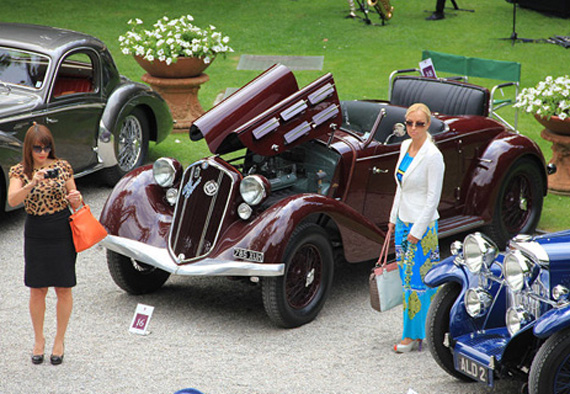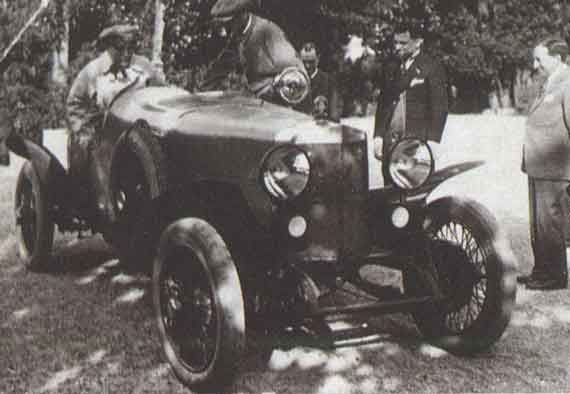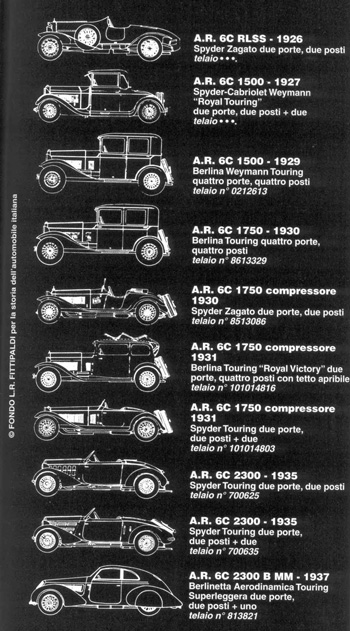The two motorists in this photo are about to share a tragedy and create an international incident hushed up for decades. Is it possible that this photo provides new evidence about this strange interlude?*Photographer unknown.
By Pete Vack
Dale La Follette, proprietor of Vintage Motorphoto, has been a fan of VeloceToday for years and often sends us photos from his amazing collection. Some are not identified, and one of our happiest yet most frustrating tasks is to identify the car or individuals in a photo. Recently, he sent us this photo with the comment, “1931 (or is it 1937?) Mussolini and Cornelius Vanderbilt taking a drive in a dual cowl something or other, oh my, not OUR Cornelius??? This is great fun sending you all my problems as you keep rising to the bait……..”. On the back of the print were vague clues including a date and an incomplete newspaper clipping.
Left, a photo found on the Internet of Cornelius Vanderbilt IV. However, we can’t confirm if the passenger in the car above is actually Vanderbilt.
It wasn’t much to work with, but we took the bait. After a significant bit of research and help from inquisitive minds, we found that this photo may have been taken shortly before Mussolini and passenger Vanderbilt tragically ran over a child but for years the Mussolini regime denied that the accident occurred. The photo…perhaps the only one in existence…may prove otherwise.
Cornelius Vanderbilt IV
Mussolini may not have been aware of it but his passenger, although a genuine Vanderbilt, did not have a great fortune. The demise of the Vanderbilt fortunes is another mystery. At the turn of the 20th century, the Vanderbilt family was as rich and famous as the Rockefellers. But by 1972, when 120 Vanderbilts gathered at a family reunion, according to Arthur T. Vanderbilt II, “…there was not a millionaire among them.”
“Our Cornelius” was in fact Cornelius Vanderbilt IV, born in 1898. Also called “Neil”, he was a direct descendant of Commodore Cornelius Vanderbilt who amassed a fortune buying railroads. Neil’s father was Cornelius Vanderbilt III, “Neily”, and did not fare well when it came to inheritance. When his father died in 1899, Neily was left only $1 million; his brother was given over $42 million.
Eventually Neily created his own fortune. But when first son Cornelius IV, the hero of our tale, thought he was to inherit $3 million at age 26, he found out differently. Needing the money to finance a growing newspaper empire, he was allowed access to the funds only with legal advice. The fledging newspaper business failed anyway and Neil saw his fortune go to pay the creditors. When he traveled to Italy a few years later in 1927, he was a Vanderbilt without a purse.
Not that Mussolini might have cared; he was more than happy to accommodate visiting dignitaries and Cornelius had both press and social credentials. Despite the failure of his newspaper chain, Cornelius IV continued to work as a reporter and writer. During a trip to interview Stalin in July of 1927, he had scheduled a visit to Rome to speak to Italy’s powerful ruler. Vanderbilt and the dictator spoke of many things, Mussolini both in his broken English and via an interpreter. Mussolini then invited Vanderbilt to return on Saturday, the 23rd . “I would like to show you my Italy,” said Mussolini.
A ride to be forgotten
Saturday morning found Vanderbilt sitting next to Mussolini “in his long, black, shining Fiat right hand drive roadster. We went roaring past towns and villages at a speed that would have [netted] us at least sixty days in jail on any highway at home,” wrote Vanderbilt. Throughout the weekend, there were many stops as Mussolini was scheduled to give speeches in the towns along the way. By Sunday night, he was tiring and wanted to find a good restaurant. Mussolini wanted to speed up. Then, according to Vanderbilt, “There was a sharp turn ahead of us leading into a village. The most reckless driver in the world would have navigated that turn at no more than thirty. We made it at near ninety. A small child ran in front of the machine and was hit. I heard a shriek and saw a group of children waving flags. I turned my head quickly. There was a shapeless little form lying on the road in back of us. ‘Look, your Excellency!’ I shouted. Mussolini placed his hand on my knee and said ‘Never look back, Vanderbilt. Always look ahead in life.’ “ For reasons unknown, Vanderbilt did not go public with this story, until 1931, the date on the back of the photograph. Then he was forced to.
General Butler’s bombshell
In a biography of General Smedley Butler, Historian Hans Schmidt writes that in a January 1931 speech, “Butler related an anecdote told him by an unnamed friend who had been taken by Mussolini for a high-speed automobile ride through the Italian countryside, in the course of which the dictator ran down a child and did not bother even to slow down.” Butler then told the audience, “My friend screamed as the child’s body was crushed under the wheels of the machine. Mussolini put a hand on my friend’s knee. ‘It was only one life,’ he told my friend. ‘What is one life in the affairs of a State?’ “ The proverbial crap hit the fan, the Italian government denied the story, the U.S. State department issued an apology to Italy, and the General was scheduled for a court martial. Obviously the General’s friend was Cornelius Vanderbilt IV. The news story generated much press in February 1931. Apparently several newspapers planned to publish the (unattributed) photo that Dale Lafollette found and sent to VeloceToday.

Mussolini owned – or was given – many Alfas and Fiats. Here is a 6C2300 Pescara once owned by Mussolini as photographed by Hugues Vanhoolandt.
Vanderbilt went public, but only insofar as stating that the General got the story right but misquoted him. Instead of ‘Never look back, always look ahead in life’, Butler twisted the quote as above. However, the court martial was called off and the issue quietly was dropped.
It is not 100% certain that the passenger in the Lafollette photo was actually Vanderbilt. The back of the print only identifies Mussolini and glued on is a newspaper paragraph about the Butler/Vanderbilt controversy. However, a comparison of period photos of Vanderbilt revealed that the passenger could easily have been Cornelius IV.
Sixteen years later
On September 28, 1943, three days after Mussolini was arrested in Rome and deposed from power, Cornelius Vanderbilt finally told the entire story of the hit and run incident in his column in the New York Post. But by then no one really cared.
Ironically, it was not the first time Vanderbilt had been involved in a motoring incident in Italy.
Willie the K
Another Vanderbilt was well known for his cars and racing. William Kissam Jr. (1878-1944) established the famous and influential Vanderbilt Cup races on Long Island at the turn of the century. In 1905, William took his wife on a vacation in Italy and while driving to Pisa accidentally hit and slightly injured a small boy. A mob appeared and Vanderbilt was jailed until his identity was verified. “Willie the K” eventually lost interest in racing and when his only son died in an automobile accident in 1933, he came to almost loath the automobile.
The mystery of the car
In his full story about the incident written in 1943, Cornelius Vanderbilt states that Mussolini’s car on that occasion was a long black Fiat. And indeed, Mussolini owned many Fiats, and well into the 1930s his son Romano recalls him coming to visit driving a Fiat 1500. But assuming the the photo La Follette sent is actually Vanderbilt and Mussolini, it indicates a very sporting body on a rather large chassis; the Fiat range at the time largely consisted of rather pedestrian six cylinder side valve cars with no sporting pretensions. More likely, in 1927, the car would have been a special bodied Alfa RL. We sent the photo around to some experts to see if they could identify the car.
Peter Marshall: What a super picture. I noticed first the dual cowl rather than the cowl under the screen on the driver’s side. I have one idea, as attached. The title is Incontri because it is from an Italian magazine (produced by the bank of Rome and portrays Alfas owned by Mussolini.
Gijsbert-Paul Berk: Concerning the photo of Mussolini and Cornelius, I agree with you that it is not a Fiat but most likely an Alfa Romeo. It looks very much like the A.R. RLSS – 1926 Spyder Zagato, duo porti, duo posti, on the drawing. This also has a ‘manhole’ in the tail and a cowl behind the windscreen. And the spare wheel is mounted at the right side at an almost identical position in both pictures.
Fred Simeone: This is a horizontally split windshield typical of R series Alfas. I could not find this exact picture but the windscreen resembles those of that period as seen in Fusi’s Le Alfa di Merosi e Romeo. None of the late 1920s Fiats had those windshields but they made few real sporty cars at that time. My GUESS is R series Alfa and if 1927 it would be an RLSS.
At left, a list and drawings of the various Alfas owned or given to Mussolini. Note the RL at the top. We have no comparable list of Fiats however. Courtesy Peter Marshall
Fiat Notes
The car. One might think it would be easy to identify but we have found it a bit difficult. In his newspaper article in 1947, Vanderbilt specifically stated that it was a “long, black Fiat.”
Fiat 509 series: 990 cc, Spinto Monza SM good for 30 hp and supercharged versions were available. Possible but tire cross section too small, also body. Mussolini would have probably opted for a more powerful car.
Fiat 503: 1460cc primarily a tourer. Side valves.
Fiat 507 2296 cc, large tourer, side valves 35 hp.
Fiat 512—1926-27, 3,446 cc, 46 hp, side valve large touring car
Fiat 520…2244 cc, side valve, only made in left drive, rules that out.
Narrowing that down, the 509 and 503 are too small, the 520 left drive, leaving the six cylinder 507 and 512 with side valve and not a sportser.
Sources
Automobile Quarterly, V15-3 “Wille K The Saga of a Racing Vanderbilt”, Kimes
Fortune’s Children, The fall of the House of Vanderbilt, Arthur T. Vanderbilt II William Morrow, 1989,
My Father il Duce, Romano Mussolini, Kales Press, 2006
New York Post, July 28th 1943
Lawrence, Kansas newspaper, February 13, 1931
Did we ask? CNN’s newsman Anderson Cooper’s mother Gloria Vanderbilt was a cousin of Cornelius IV. We asked his agent if he might get a chance to review the above story and comment or perhaps verify the person in the lead photo. He has not return our queries.
*There was no photo source stamped on the back of this print photo, which was published in a variety of newspapers in 1932. We checked the Internet for the usual collections but found no one claiming rights. Please contact us if you are the verified copyright holder of this photo.




Pete,
M. Marchiano answers your question is his 1984 “Zagato”: “But the most appreciated car in these early years of activity (of Zagato) was the Alfa Romeo RLSS spider, that even Benito Mussolini decided to purchase in 1924”. He goes on to say that two years later Ugo Zagato built two more nearly identical RLSS touring cars, one of which came in 3rd at the German Grand Prix at Avus in 1926.
Sorry, didn’t finish. Since the ’26 car was a “touring body” and nearly won the German GP, and belonged to the German Zagato Rep; I would speculate that it would have been sold to Mussolini and would be the one in the picture. Whatever, definitely an Alfa RLSS.
A great detective story, nicely illustrated and a thoroughly good read. Let’s hope more emerges.
I agree: not a Fiat …. rather, a custom bodied 1926 Alfa Romeo RLSS (Castagna?)
Just look at the 52 mm spare wheel/ two eared knock off (spinner). If the photo was sharper, one would be able to read the Alfa script.